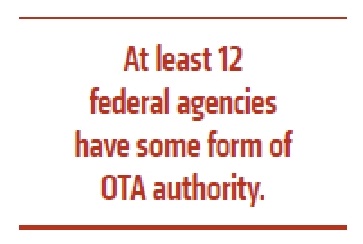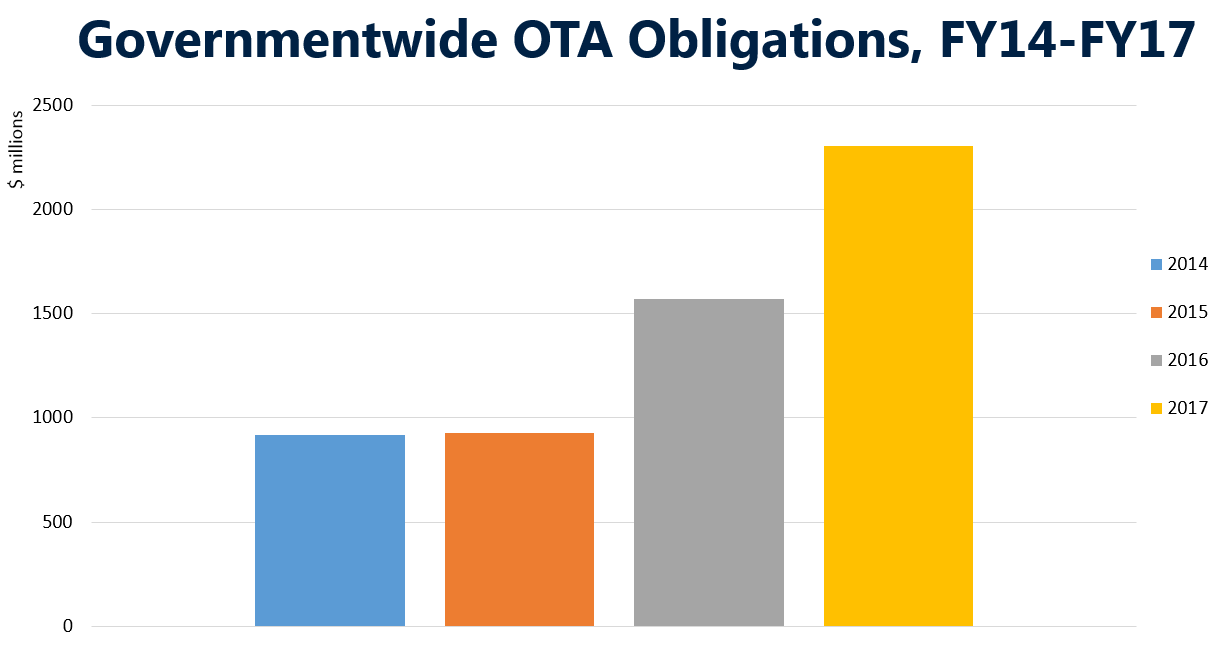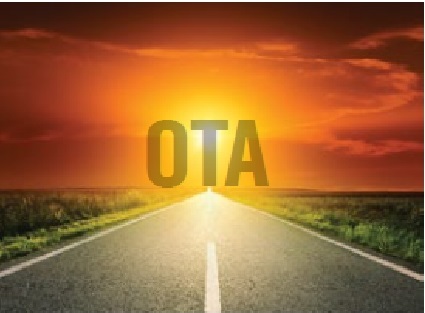Beyond the FAR: Growth of OTAs Changing Procurement Landscape
By Kevin Cummins
PSC Vice President of Technology
The Federal government has a tremendous opportunity today to access Americans’ amazing capacity to innovate and harness the best ideas that the private sector has to offer. But those working in the trenches can feel constrained by slow budget processes and cumbersome acquisition rules that impede access to commercial solutions. Agencies are increasingly leveraging Other Transaction Agreements (OTAs) to spur innovation, acquire cutting-edge technologies, and adapt business practices. Will OTA transform acquisition, or is it just a niche tool or passing trend?
While contracts and grants are by far the government’s main acquisition mechanisms, federal spending through OTAs increased significantly from less than $1 billion in FY15 to $2.3 billion in FY17. Although the Department of Defense (DoD) accounts for most of the total dollar amount of OTA awards, with $2.1 billion in FY17, at least 12 agencies have some form of OTA authority. PSC expects spending through OTAs to continue to increase in FY18.
 What are OTAs?
What are OTAs?
OTAs can be described by what they are not. Other Transaction Agreements (OTAs) are not Federal Acquisition Regulation (FAR) contracts, cooperative agreements (e.g. CRADAs) nor grants. First pioneered by NASA, this authority is primarily designed as a special vehicle for obtaining or advancing R&D and prototypes. In general, the policy rationale for using OTA is that the government needs to obtain cutting-edge technology from commercial sources, but some private entities are unwilling or unable to comply with federal procurement regulations. Under OTAs, agencies have greater flexibility to tailor agreements for a particular transaction.
OTAs are not subject to the FAR system, government cost accounting standards, and most procurement statutes. These flexibilities can make OTA a helpful tool for agencies. DoD’s Defense Innovation Unit Experimental (DIUx), for example, uses OTA authority as the basis for its “Commercial Solutions Offerings” (CSOs) with awards often made in less than 60 days. Unlike FAR-based contracts, OTA awards mostly cannot be protested, however, the Government Accountability Office (GAO) can determine if OTA is the appropriate contract vehicle and did recently sustain a protest of a DoD follow-on OTA award.
 Defense Department Usage of OTAs
Defense Department Usage of OTAs
While OTAs are generally limited to “prototype” projects, DoD policy guidelines allow for a flexible definition for such prototypes. While OTAs are mostly still used for traditional R&D activities, recent awards have focused on cloud migration and cybersecurity services.
DoD also has a unique “production” OTA authority that allows for follow-on awards that can be sole-sourced if the initial protype OTA was successful and competitive procedures were used to select the parties participating in the initial award.
DoD’s OTA policy encourages participation of “nontraditional” defense contractors, defined as companies that have not performed a CAS-covered DoD contract for at least one year. Nontraditional defense contractors and small businesses can obtain an OTA award without restriction. “Traditional” defense contractors may receive an OTA award when partnering with a nontraditional defense contractor or contributing at least one-third cost share.
Defense agencies have also pioneered the use of OTA “consortia” and execute a single OTA with an organized group of private entities that agree to participate under common terms. The agency solicits proposals for projects to the consortium, whose members can then compete (and team) for. These consortia can help foster open communication between government and industry around current agency challenges as well as industry state-of-the-art and emerging trends. The consortium model can also facilitate participation and partnerships among traditional and nontraditional defense contractors. There are at least 23 OTA consortia today, with four more proposed. But not all consortia are at DoD.
The flexibility that makes OTAs so useful can also create challenges. Since OTAs are exempt from the FAR and several other procurement laws, companies may want to “negotiate up” their protections or requirements that are typically included in a FAR-based contracts, such as IP protections or changes clauses.
 Congressional Concerns
Congressional Concerns
The increased use of OTAs has caught the attention of Congress as well. The House version of the FY19 National Defense Authorization Act (NDAA, H.R. 5515) requires that DoD follow-on “production” OTAs be subject to same approval and reporting requirements as the initial award. The Senate’s companion legislation (S. 2987) requires that the cost of a follow-on “production” OTA be added to the cost of the initial OTA award for purposes of determining DoD approval level and reporting requirements. Congress may also extend OTA authority to additional agencies, such as to National Institutes of Health (NIH) to help combat the opioid epidemic (S. 2987). PSC closely follows these developments and will continue to engage on OTA-related policy issues.
What’s the Big Deal?
Much of the attention on OTAs today focuses on the perception that this acquisition tool can be used to cut through burdensome and time-consuming FAR-based regulations and processes. As PSC has previously noted, if the FAR is the problem, then it should be reformed and streamlined. In reality, FAR contracts can be successfully used to acquire cutting-edge technologies, yet contracting officials are often risk averse and avoid using innovative procurement approaches.
Ultimately, the increased use of OTAs may have greater potential to transform federal acquisition, not as a “work around” to the FAR, but by highlighting how to improve federal procurement. OTAs have enormous value, but they do require immense time and work. PSC expects the use of OTAs to grow in the near term, which may help agencies acquire solutions in a more commercial-like manner that ultimately helps the government become a better buyer.
Learn more
Watch PSC’s OTA Webinar – July 2018
